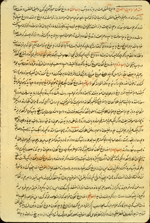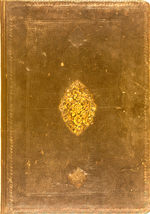Catalogue: Pharmaceutics
-
 Qarābādhīn (MS P 11, item 2)
Qarābādhīn (MS P 11, item 2) - (Formulary)
- قراباذين
- by Aḥmad ibn Farrukh (fl. early 12th century)
- احمد ابن فرخ
This is a formuary in 11 short chapters (babs), and it appears to be the only preserved example of the writings of Aḥmad ibn Farrukh.
Aḥmad ibn Farrukh was the teacher of the physician Ismā‘īl ibn al-Ḥusaynī al-Jurjānī (d. 1136/531). He was also the author of a Persian medicine encyclopaedia titled Kifayah that is no longer extant though it had a high reputation among scholars long after al-Jurjānī's day.
Aḥmad ibn Farrukh's name was often (as in the manuscript below) written as Aḥmad-i Farrukh. This reflects the Persian habit of replacing the Arabic ibn ('son of') with the grammatical structure of idafa or possessive. Thus Avicenna's name was often written in Persian as Abū ‘Alī-i Sīnā rather than the Arabic form Abū ‘Alī ibn Sīnā. For this Persian custom of writing names, see Lutz Richter-Bernburg, 'Going Places with Naser-e Khosrow and his Translator', Die Welt des Islam, vol. 3 (1993), pp. 263-275.
Qarābādhīn (MS P 11, item 2)
Illustrations
The opening page of a formulary of compound remedies by Aḥmad ibn Farrukh, the teacher of the physician al-Jurjani (d. 1136/531). The title and author are given in the heading at the top of the page, which reads: min Qarābādhīn-i Aḥmad-i Farrukh ('from the Formulary of Aḥmad ibn Farrukh'). No other copy is recorded, and this appears to be the only preserved treatise by Aḥmad ibn Farrukh. The copy was completed by the same copyist as transcribed the previous item in the volume, which was competed on 5 Muharram 1248 [= 4 June 1832] by Ibn ‘Abd al-‘Azīm Muḥammad Samī‘ al-ṭabīb (the physician).
The volume is bound in a 19th-century Persian binding of black leather over pasteboard. Each cover has a central panel stamp impressed over tan-colored paper cut roughly to its contours. The central panel is lozenge-shaped with scalloped contours and inner field of flowers and stems. On the vertical axis there are two pendant stamps similarly impressed over tan-colored paper. The frames surrounding the design are blind-tooled and composed of simple fillets and a string of S-shaped stamps.
Physical Description
Persian. 2 leaves (fols. 340a-341a, line 19). Dimensions: 30.2 x 20.8; text area 22 x 13.3 cm; 23 lines per page. The title and author are given at the start of the text on fol. 340a, where the heading reads min Qarābādhīn-i Aḥmad-i ibn Farrukh ('from the Formulary of Aḥmad ibn Farrukh').
The copy was completed by the same copyist as transcribed the previous item in the volume, which was competed on 5 Muharram 1248 [= 4 June 1832] by Ibn ‘Abd al-‘Azīm Muḥammad Samī‘ al-ṭabīb (the physician).
The text is written in a small to medium-small nasta‘liq script, using black ink with headings in red, red overlinings, and some marginal headings. There are catchwords.
The creamy, smooth, glossy paper has evident watermarks, with laid lines and single chain lines. There is water damage near the edges; the edges have been trimmed from their original size.
The volume contains 342 leaves. Fols. 1b-339b (item 1) is a medical compendium by al-Nūrbakhshī (MS P 11, item 1); fols. 340a-341a (item 2) is the formulary by Aḥmad ibn Farrukh here catalogued; and fols. 341a, line 20,-342a (item 3) is an anonymous essay on antidotes for poisons (MS P 11, item 3). Fol. 342b is blank. Between fols. 33 and 34 and between fols. 181 and 182 there are small slips of paper with jottings in a modern hand. The first 250 leaves have been numbered with Arabic numerals, with two leaves given the number 241. Consequently, the recent foliation using Western numerals differs by one, beginning with fol. 242 (old fol. 241 bis).
Binding
The volume is bound in a 19th-century Persian binding of black leather over pasteboard. Each cover has a central panel stamp impressed over tan-colored paper cut roughly to its contours. The central panel is lozenge-shaped with scalloped contours and inner field of flowers and stems. On the vertical axis there are two pendant stamps similarly impressed over tan-colored paper. The frames surrounding the design are blind-tooled and composed of simple fillets and a string of S-shaped stamps. The spine and edges have been repaired. There are blue paper pastedowns and modern endpapers.
Provenance
On fol. 1b there is an owner's stamp and an owner's note on fol. 1a; neither are legible.
The volume was purchased by the Army Medical Library in 1946 from A.S. Yahuda, who acquired it from a dealer in Lahore, Pakistan (ELS 1615).
References
Schullian/Sommer, Cat. of incun. & MSS., p. 333 entry P11, where the name of the author is interpreted as the otherwise unknown Ahmad Faraj.
NLM Microfilm Reel: FILM 48-133 no. 1












